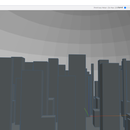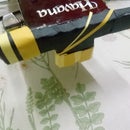Introduction: Distorted Tetrahedral Piece
3-D geometry is fascinating. We do live in a 3-d world, but still find it difficult visualizing 3-d stuff in our heads.
One of the many simple, elegant 3D models is a Tetrahedron. Basically two square pyramids joint base to base.
This is the configuration you'd find in diamonds with some spectroscopy.
The goal for this project was to make a bounce-able tetrahedron, with some satisfying shock absorbers....but...it didn't go as planned, and I ended up making a "star" that would diffuse light, hold your stationery, and just look pretty.
Supplies
Hot glue
Sandpaper( 180-grit )
Old discarded markers
Toothpicks
Rubber bands.
Step 1: Making the Core.
The core is made of 6-pieces, stretching along the x,y,z axes.
Cut the markers into 6 equal, (hollow) tubes.
Sand the edges and the surfaces.
Using a central, suitably sized piece, which keeps things oriented perpendicularly, make a cross using 4 such tubes.
Secure this structure with hot glue.
Add the remaining two tubes perpendicular to the plane of the cross.
Step 2: Improving Structural Integrity.
Use toothpicks to connect every tube to its immediate neighbours. So every tube gets connected to every other tube perpendicular to it, so one tube has four connections.
I made eight instead of four, so for every connection, a pair was substituted.
At this point, you can really see the tetrahedron emerge.
Connections:
1 - ( 2 , 4 , 5 , 6 )
2 - ( 1 , 3 , 5 , 6 )
3 - ( 4 , 2 , 5 , 6 )
4 - ( 1 , 3 , 5 , 6 )
5 - ( 1 , 2 , 3 , 4 )
6 - ( 1 , 2 , 3 , 4 )
The connections are double counted, but the only goal was to show what connections exist.
Step 3: Rubber Bands.
Using rubber bands, cover the structure.
Each rubber band goes over tubes that lie on the same plane.
On the number scheme, each rubber band goes over:
( 1 , 2 , 3 , 4 )
( 1 , 2 , 5 , 6 )
( 3 , 4 , 5 , 6 )
Each number through one to six occurs exactly twice here. So on a single vertex sees two rubber bands passing through it.
To make the rubber bands look denser, I ran over 4 instead of a single rubber band on every plane. That's a total of 12 rubber bands.
Step 4: Distorting the Octahedron.
At this point, the octahedron looks beautiful. Side note, an octahedron is one of the 5 platonic solids. A platonic solid is a structure where every face, angle and side is identical to the other, and the same number of faces meet at each vertex.
The distortion we are going to cause will introduce curves to the structure, but the symmetry will be maintained, however, it'll no longer be a platonic solid, because they are devoid of curves.
DISTORTING: This time, rubber bands will only go over tubes a 180 degrees apart, twice, and 90 degrees away; That is :
2 X ( 5 , 6 )
2 X ( 1 , 3 )
2 X ( 2 , 4 )
The rubber bands will push in the already placed rubber bands, till they meet the toothpicks.
Step 5: .....
Done.
This goes quite well with my table lamp...it holds quite some stuff.
The phone camera doesn't do justice to how it looks. Take my word for it, it's amazing.






